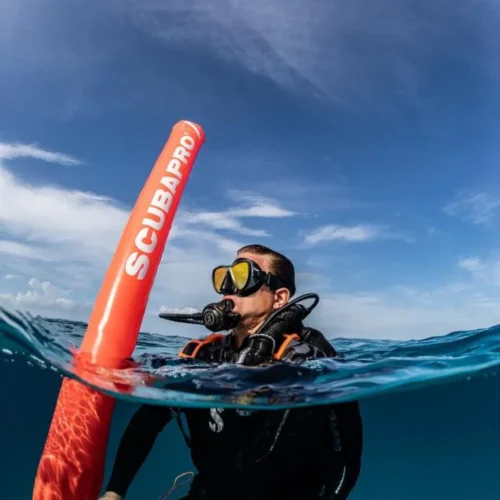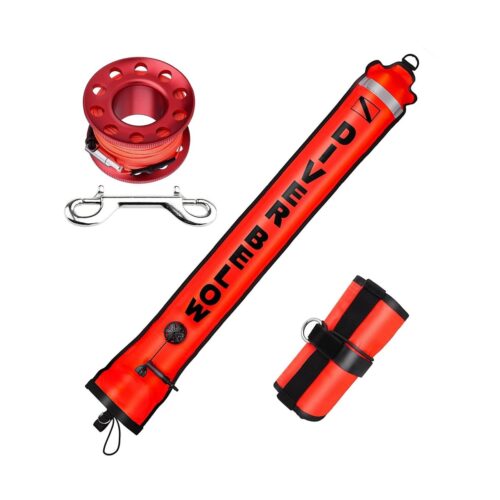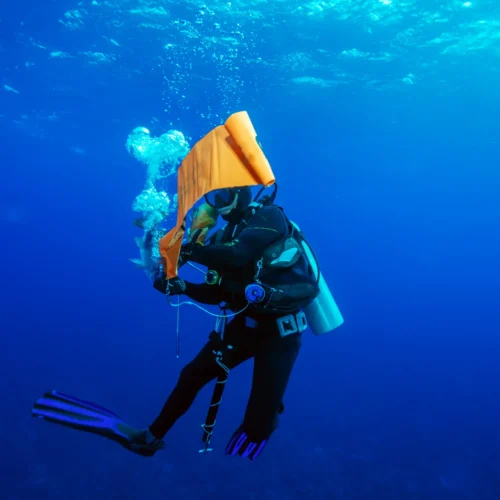The Surface Marker Buoy (SMB): Your Vital Communication Link to the Surface
In the world of diving, one of the most potentially hazardous moments is your ascent. You could be in an area with heavy boat traffic, or a subsurface current could have pushed you far from your dive boat without you even realizing it. How do you clearly and safely signal your position to the surface world? The answer is the Surface Marker Buoy (SMB).
Deploying an SMB is not just a “nice-to-have” skill; for a responsible diver, it’s mandatory. However, if done incorrectly, it can cause more trouble than it’s worth. This article in Amadive’s Mastering Core Dive Skills series will be your in-depth workshop, from choosing the right gear to a step-by-step deployment process and how to manage common issues.
Why is an SMB So Important?

- Communication: It’s a bright, visual signal (usually orange or yellow) that a boat captain can see from a great distance, even in choppy seas.
- Ascent Safety: It alerts other boat traffic that divers are ascending in the area, telling them to keep clear.
- Safety Stop Reference: The line provides an excellent visual reference for maintaining a stable 5-meter (15-foot) depth.
- Emergency Tool: In an out-of-air or drift-away emergency, a tall, bright SMB makes you far more visible to rescue teams.
Choosing the Right Equipment: Spool vs. Reel

- The Spool (Finger Spool):
- Description: A simple, round spool of line with no handle. You let the line pay out through your fingers.
- Pros: Compact, less prone to jamming, perfect for recreational diving in open water.
- Cons: Harder to wind back up, especially with thick gloves.
- The Reel:
- Description: A larger spool with a winding handle and a locking mechanism.
- Pros: Holds more line, easy to wind up.
- Cons: Bulkier, and has a higher risk of creating a “bird’s nest” (a massive tangle) if not used correctly.
- Amadive’s Advice: For 99% of recreational dives, a 20-30 meter (60-100 foot) spool is the simplest, safest, and most effective choice.
The Step-by-Step Safe Deployment Process (The Amadive Method)

Practice this process until it becomes second nature.
- Phase 1: Prepare and Stabilize (The Most Important Step)
- Action: Swim away from the reef or wall. Make sure you have clear space above you. Establish perfect neutral buoyancy. Do not attempt anything else until you are hovering effortlessly.
- Why it’s critical: Most problems occur when a diver is fumbling with their SMB and forgets to monitor their buoyancy.
- Phase 2: Underwater Assembly
- Action: Take out your SMB and spool. Clip the end of the spool’s line to the D-ring on the SMB. Unfurl the SMB and have the open end ready.
- The Golden Safety Rule: NEVER clip the spool to your BCD or any part of your body. Always hold it in your hand.
- Phase 3: Inflation
- The Most Recommended Method (Safe & Easy): Use your alternate air source (Octopus). Place the mouthpiece of the octopus into the open end of the SMB and press the purge button for 2-3 seconds. The expanding gas on ascent is enough to inflate it.
- The Alternate Method: Exhale from your mouth. This requires removing your primary regulator momentarily and should be well-practiced.
- Phase 4: Release and Deploy
- Action: As the SMB begins its ascent, let the spool slowly spin and release the line through your fingers. Do not grip it; just let it glide.
- Pro Tip: Tilt the spool slightly to allow the line to pay out more smoothly. Hold your arm slightly away from your body to prevent the line from snagging on your gear.
Troubleshooting Common Problems

- Problem: The spool/reel jams.
- Solution: Do not panic. Immediately LET GO of the spool. A plastic spool will be neutrally buoyant or sink slowly. Your safety is more important than a piece of gear. You can retrieve it later.
- Problem: The line gets entangled in your gear.
- Solution: Stop. Do not struggle. Ask your buddy to help untangle the line. This is precisely why you never clip the spool to your body.
Conclusion: The Skill of Confidence and Responsibility
Deploying an SMB smoothly and without thought is one of the clearest signs of an experienced and safety-conscious diver. It shows your captain, your buddy, and yourself that you are a competent diver who is in control of the situation. Take the time to practice this skill, and it will serve you well for your entire diving career.
